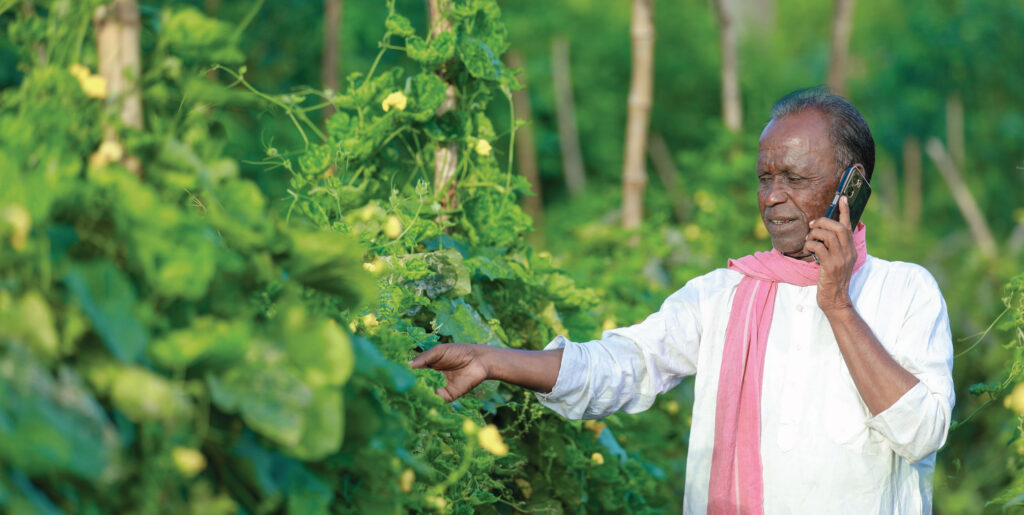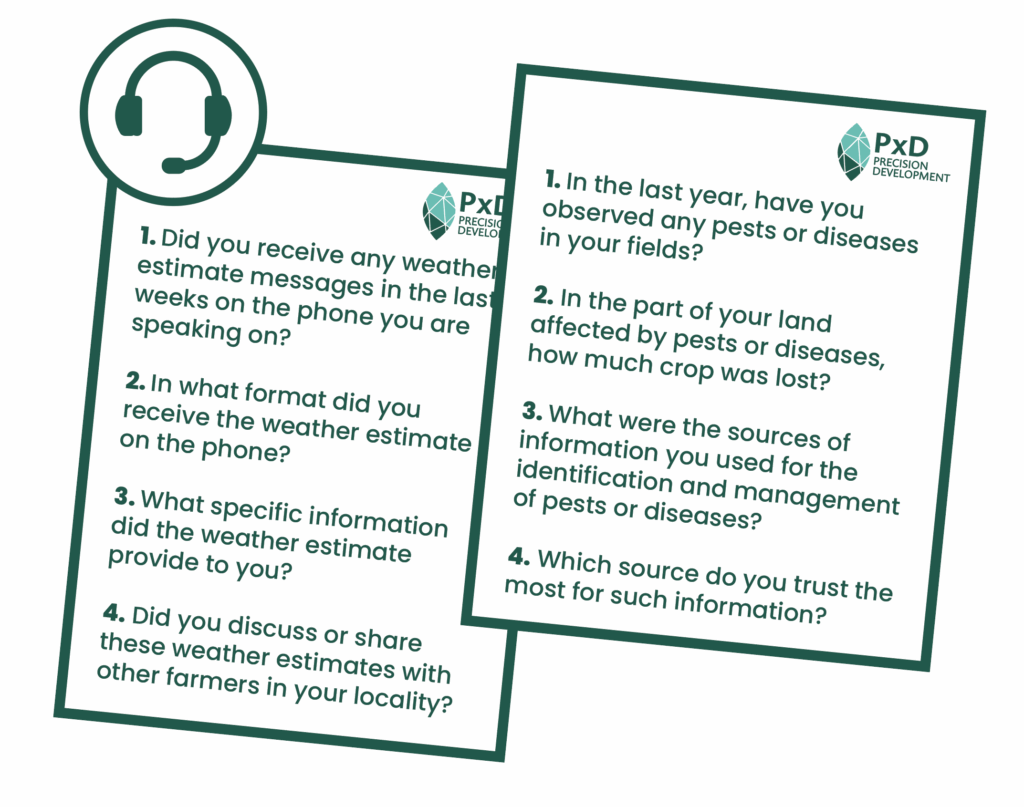The Fields are Calling: Leveraging India’s Kisan Call Centres for Farmer Surveys—Opportunities and Lessons
- October 17, 2025
- 10 minutes read

The launch of Kisan Call Centres (KCCs) in 2004 was one of India’s first large-scale efforts to use technology for agricultural extension. Using a toll-free number, farmers can connect with trained Farm Tele Advisors (FTAs) for localized advice on crops, pest management, and government schemes. Over the years, KCCs have become a central node in India’s agricultural knowledge system, and now field millions of calls annually.
Working with the Ministry of Agriculture & Farmers’ Welfare’s Digital Agriculture Mission, Precision Development (PxD) supports a Project Management Unit (PMU) tasked with strengthening such public infrastructure. This has meant exploring the potential of KCCs beyond their advisory services—specifically, using KCCs as a platform for systematic farmer surveys.

The logic is compelling: KCCs are uniquely positioned for large-scale feedback collection as they combine nationwide reach, multilingual capacity, cost efficiency, and established farmer trust.
This blog synthesizes our key learnings from training FTAs and piloting outbound surveys across multiple KCCs, and highlights both the promise and the institutional challenges of expanding the KCC mandate.
Why Collect Feedback from Farmers?
At the heart of agricultural policymaking and program delivery are the farmers themselves—the intended users of schemes, advisories, and digital tools. Collecting feedback is essential because it bridges the gap between policy intent and ground reality.
Feedback from farmers provides invaluable insights into what works, what doesn’t, and why. For example, a feedback exercise revealed that, while a digital advisory platform was technically sound, many farmers were still unaware of its existence and continued relying on in-person sources for pest and disease management. This highlighted that, alongside improving the tool itself, it was necessary to pay equal attention to building the awareness and trust of farmers, to ensure meaningful uptake.
Real-time feedback mechanisms—such as call centres, SMS surveys, or WhatsApp polls—enable programs to adapt quickly, thereby ensuring interventions are responsive to farmers’ lived realities rather than being static blueprints. In this way, feedback is not just a diagnostic tool but a driver of adaptive, farmer-centered policymaking.
Why use call centres for surveys?

Conventional farmer surveys in India rely on face-to-face fieldwork—a method that, while rigorous, is often slow, resource-intensive, and logistically demanding. Phone-based surveys offer an alternative that addresses many of these constraints. They enable:
- Speed: Data can be collected within days rather than weeks.
- Cost-efficiency: Expenses are considerably lower for surveys than for in-person methods.
- Scalability: Outreach is not constrained by geography, seasonality, or field conditions.
The existing institutional infrastructure of KCCs and the trust they have built among farmers sets KCCs apart. Unlike generic survey operations, KCCs already engage with millions of farmers who are seeking advice. Selectively integrating surveys into the primary agricultural extension role of KCCs thus enables systematic feedback, policy monitoring, and rapid assessments at scale.
Our pilot: Embedding surveys in KCCs
In collaboration with the Ministry of Agriculture & Farmers’ Welfare, we piloted the integration of outbound surveys directly into the KCC system.
The surveys focused on themes central to agricultural policy and extension effectiveness, including:
- Farmers’ experiences with government schemes.
- Feedback on advisory messages previously disseminated.
- Pest and disease incidence, and the efforts farmers took to identify and manage those pests or diseases.
Our pilots demonstrated the operational feasibility of such surveys and highlighted how public extension assets can be adapted to generate timely, policy-relevant feedback at scale.

Key learnings
1. Optimize the Survey Design for KCC Contexts
Designing effective surveys for KCCs requires balancing technical rigor with the practical realities faced by FTAs and farmers. For example, using local crop calendars and familiar technology—especially for pests and diseases—helps make conversations more natural and engaging.

We also observed a tendency for farmers to over-report engagement with government schemes or apps, which likely reflects the farmers’ association of KCCs with official government programs. Breaking such questions into sequential steps (awareness → download → use) helped reduce this bias. For instance, when farmers were directly asked if they use a particular government app, many tended to answer “yes”. But when we broke the question into sequential steps—first asking if they had heard of the app, then if they had downloaded it, and finally if they had actually used it—the numbers dropped significantly at each stage. This stepwise approach made it harder for farmers to overstate engagement and gave us a more accurate picture of actual usage.
2. Build an FTA Toolkit for Neutral Survey Techniques
Because FTAs are primarily trained to assist and advise farmers during inbound calls, they naturally adopt a helpful, solution-oriented tone. When this approach carries over into survey interactions, it can lead farmers toward certain answers instead of eliciting neutral responses. This tendency is addressed in training. Modules that clearly distinguish between probing and leading, and that emphasize the value of neutrality in data collection, help strengthen the reliability of responses in surveys. Similarly, checking for such tendencies during audio audits can further improve data integrity.
3. Involve KCC Supervisors Early to Reduce Survey Edits
Supervisors regularly monitor calls and understand the language farmers relate to and the questions that cause confusion. Involving supervisors early in the design of a survey helps to refine the wording and adjust choice-lists, thereby improving the quality of responses and reducing the number of edits after the pilot phase.
4. Train FTAs effectively
Effective FTA training at KCCs requires balancing the training with the demanding ongoing call-centre operations of handling diverse farmer inbound queries. Splitting training sessions by shift and keeping groups small (15–20) ensure adequate coverage of inbound calls while still allowing the FTAs to participate in the training. Simple arrangements—like refreshments, printed materials, and quiet spaces—help the FTAs sustain their attention in what is otherwise a high-pressure, call-heavy environment.
Mock sessions often simulate “difficult call” scenarios to build confidence. Local language nuances and examples from actual farmer interactions make training directly relatable. Finally, practical job aids—like pest/disease cheat sheets or quick-reference guides—help FTAs retain information and perform under time pressure.
5. Check Data Quality
Ideally, supervisors would backcheck 10% and audio audit 5% of all calls weekly, to catch errors or inconsistencies promptly. In practice, KCC supervisors are often managing multiple responsibilities—including handling live farmer calls, troubleshooting FTA queries, and reporting—so this frequency is difficult to sustain. A workable compromise has been to conduct smaller, more targeted checks: for example, auditing calls from new or less experienced FTAs, or inserting checks for type 2 errors into the audio audit form. This approach balances maintaining data reliability with the operational realities of a busy KCC.

6. Consider Seasonality and Workloads
The primary function of KCCs is handling inbound farmer calls, which naturally takes precedence over conducting surveys. During peak agricultural seasons, this priority can reduce the availability of FTAs for conducting surveys, which leads to fluctuations in survey productivity. Planning surveys around seasonal workloads helps to set more realistic timelines.
Challenges to Consider
Using KCCs to institutionalize surveys presents several operational and design hurdles. One of the biggest constraints is agent workload. FTAs already juggle a high volume of inbound calls from farmers seeking urgent advice, and adding surveys to this workload risks overextending the FTAs. Without careful scheduling and setting realistic targets, the quality of surveys could decline and farmers’ experiences of inbound support might suffer. Another challenge lies in data integration. While surveys can generate rich insights, linking survey data with existing government systems requires strong planning, interoperable IT frameworks, and clarity on data ownership. Without these safeguards, survey findings easily remain siloed rather than being fed back into policy and program design.
An equally important challenge is farmer engagement. If farmers receive too many calls, particularly from multiple surveys or overlapping government initiatives, then there is a real risk of fatigue, which lowers response rates and could erode trust in KCCs as a reliable service. Excluding farmers who have already been surveyed and then randomly sampling new ones, while keeping surveys short, relevant, and well-timed, is crucial to maintaining goodwill. At the same time, governments face a trade-off between flexibility and standardization. Different states may want to adapt surveys to reflect local priorities, but too much variation undermines comparability and weakens the ability to track outcomes at scale. Striking this balance—between state-specific needs and standardized protocols—is one of the toughest remaining challenges in the process of institutionalizing KCC surveys.
Opportunities ahead
Based on the surveys conducted so far, we see several promising use cases for institutionalizing outbound surveys conducted by KCCs.
- Policy feedback loops: The results of outbound surveys are direct channels for governments to hear from farmers how flagship schemes are performing on the ground. Instead of relying only on administrative reports, policymakers can draw on farmers’ lived experiences to find out whether processes are accessible, benefits are reaching farmers on time, and where bottlenecks exist. This real-time feedback can help fine-tune implementation and improve accountability.
- Early warning systems: KCCs can serve as a scalable platform to monitor crop health and pest conditions. By gathering information directly from farmers at regular intervals, governments can identify outbreaks before pests spread widely. Rapid, localized responses—through advisories, input support, or targeted interventions—can help to reduce crop losses and improve crop resilience.
- Advisory refinement: Outbound calls also offer a structured way to check whether farmers remember, trust, and adopt the practices recommended to them. By asking simple recall or follow-up questions, program developers can gauge how messages are landing and adapt the messages—in terms of timing, clarity, or format—to make advisories more actionable.
- Service quality checks: Finally, KCCs themselves can be improved using the results of outbound surveys that assess farmer satisfaction with the advisory services they receive. Tracking whether queries were resolved, if farmers found the advice useful, and whether they would call again helps to improve both the training of FTAs and the overall service delivery by KCCs.
In sum, using KCCs to institutionalize outbound surveys has the potential to create a continuous, farmer-centered feedback system—one that not only informs policies but also makes extension services more adaptive, responsive, and effective.
Conclusion
India’s KCCs were built as a lifeline for farmers in need of timely advice, and our pilot surveys show that KCCs can play a much broader role as a scalable channel for amplifying the voices of farmers. By conducting structured outbound surveys, KCCs can help policymakers move beyond top-down designs and can create real-time feedback loops that strengthen accountability and farmer-trust. The opportunities are significant: From monitoring crop and pest outbreaks to refining advisories and checking service quality, KCCs can evolve into a responsive, farmer-centered data system.
Yet, realizing this vision will require navigating the challenges of agent workload, survey fatigue, data integration, and the balance between state-specific flexibility and national standardization. These hurdles are not insurmountable, but they demand thoughtful design, realistic pacing, and sustained investment in both people and systems. If addressed well, KCCs could transition from being a one-way advisory line to becoming a two-way bridge—where farmers are not just recipients of information, but active shapers of the policies and services that affect their lives. The fields are calling, and with KCC surveys, their voices can be heard more clearly than ever before.

Stay Updated with Our Newsletter

Make an Impact Today


